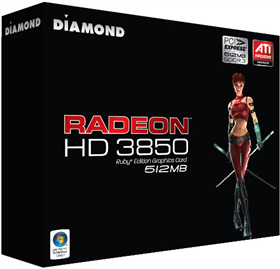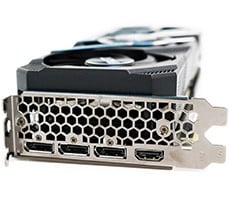
With recent price cuts to current generation Radeon HD 3800 series cards, due to increased competition from new mainstream graphics cards from NVIDIA, there is a large gap in ATI's product stack between the sub-$200 Radeon HD 3870 and the now roughly $400 Radeon HD 3870 X2. Until AMD readies a new batch of GPUs to fill this hole in their product stack, board partners are left to tweak current designs to entice potential consumers.
Diamond is one of a group of manufacturers that continue to release updated revisions of both Radeons, either by adding additional memory, raising clock speeds, or sometimes both. The model we will be taking a look at today is the Viper Radeon HD 3850 512MB Overclocked Ruby Edition - perhaps one of the longest names for a single product that we've come across. Like the Sapphire Ultimate HD 3850 that we evaluated back in January, the Viper Radeon HD 3850 512MB Overclocked Ruby Edition's frame buffer has been doubled from 256MB to 512MB. Additionally, Diamond has gone an extra step and raised GPU and memory speeds from the default 670/830MHz of reference designs to 725/900MHz. Higher speeds and more memory just might be what the doctor ordered to make the Diamond Viper HD 3850 512MB a bit more competitive in an already crowded field.
|

|
| Diamond Viper Radeon HD 3850 512MB |
| Features & Specifications | |
| 666 million transistors on 55nm fabrication process
256bit 8-channel GDDR3 memory interface
Ring Bus Memory Controller
- Fully distributed design with 512-bit internal ring bus for memory reads and writes
- Optimized for high performance HDR (High Dynamic Range) rendering at high display resolutions
Unified Superscalar Shader Architecture
- 320 stream processing units
- Dynamic load balancing and resource allocation for vertex, geometry, and pixel shaders
- Common instruction set and texture unit access supported for all types of shaders
- Dedicated branch execution units and texture address processors
- 128-bit floating point precision for all operations
- Command processor for reduced CPU overhead
- Shader instruction and constant caches
- Up to 80 texture fetches per clock cycle
- Up to 128 textures per pixel
- Fully associative multi-level texture cache design
- DXTC and 3Dc+ texture compression
- High resolution texture support (up to 8192 x 8192)
- Fully associative texture Z/stencil cache designs
- Double-sided hierarchical Z/stencil buffer
- Early Z test, Re-Z, Z Range optimization, and Fast Z Clear
- Lossless Z & stencil compression (up to 128:1)
- Lossless color compression (up to 8:1)
- 8 render targets (MRTs) with anti-aliasing support
- Physics processing support
Full support for Microsoft DirectX 10 / 10.1
- Shader Model 4.0
- Geometry Shaders
- Stream Output
- Integer and Bitwise Operations
- Alpha to Coverage
- Constant Buffers
- State Objects
- Texture Arrays
Dynamic Geometry Acceleration
- High performance vertex cache
- Programmable tessellation unit
- Accelerated geometry shader path for geometry amplification
- Memory read/write cache for improved stream output performance
Anti-aliasing features
- Multi-sample anti-aliasing (up to 8 samples per pixel)
- Up to 24x Custom Filter Anti-Aliasing (CFAA) for improved quality
- Adaptive super-sampling and multi-sampling
- Temporal anti-aliasing
- Gamma correct
- Super AA (CrossFire configurations only)
- All anti-aliasing features compatible with HDR rendering
CrossFire Multi-GPU Technology
- Scale up rendering performance and image quality with 2 or more GPUs
- Integrated compositing engine
- High performance dual channel interconnect
|
CrossFire Multi-GPU Technology
- Scale up rendering performance and image quality with 2 or more GPUs
- Integrated compositing engine
- High performance dual channel interconnect
Texture filtering features
- 2x/4x/8x/16x high quality adaptive anisotropic filtering modes (up to 128 taps per pixel)
- 128-bit floating point HDR texture filtering
- Bicubic filtering
- sRGB filtering (gamma/degamma)
- Percentage Closer Filtering (PCF)
- Depth & stencil texture (DST) format support
- Shared exponent HDR (RGBE 9:9:9:5) texture format support
ATI Avivo HD Video and Display Platform
- Two independent display controllers
- Drive two displays simultaneously with independent resolutions, refresh rates, color controls and video overlays for each display
- Full 30-bit display processing
- Programmable piecewise linear gamma correction, color correction, and color space conversion
- Spatial/temporal dithering provides 30-bit color quality on 24-bit and 18-bit displays
- High quality pre- and post-scaling engines, with underscan support for all display outputs
- Content-adaptive de-flicker filtering for interlaced displays
- Fast, glitch-free mode switching
- Hardware cursor
- Two integrated dual-link DVI display outputs
- Each supports 18-, 24-, and 30-bit digital displays at all resolutions up to 1920x1200 (single-link DVI) or 2560x1600 (dual-link DVI)
- Each includes a dual-link HDCP encoder with on-chip key storage for high resolution playback of protected content
- Two integrated 400 MHz 30-bit RAMDACs
- Each supports analog displays connected by VGA at all resolutions up to 2048x1536
- HDMI output support
- Supports all display resolutions up to 1920x1080
- Integrated HD audio controller with multi-channel (5.1) AC3 support, enabling a plug-and-play cable-less audio solution
- Integrated Xilleon HDTV encoder
- Provides high quality analog TV output (component / S-video / composite)
- Supports SDTV and HDTV resolutions
- Underscan and overscan compensation
- HD decode for H.264/AVC, VC-1, DivX and MPEG-2 video formats
- Flawless DVD, HD DVD, and Blu-Ray playback
- Motion compensation and IDCT (Inverse Discrete Cosine Transformation)
- HD video processing
- Advanced vector adaptive per-pixel de-interlacing
- De-blocking and noise reduction filtering
- Edge enhancement
- Inverse telecine (2:2 and 3:2 pull-down correction)
- Bad edit correction
- High fidelity gamma correction, color correction, color space conversion, and scaling
- MPEG-2, MPEG-4, DivX, WMV9, VC-1, and H.264/AVC encoding and transcoding
- Seamless integration of pixel shaders with video in real time
- VGA mode support on all display outputs
PCI Express 2.0 x16 bus interface
OpenGL 2.0 support

|
In order to really get a handle on how the Viper performes we're going to pit it against the aforementioned Sapphire HD 3850 and also compare it to an ATI Radeon HD 3870 for good measure. With the basic architecture remaining the same, we fully expect that the boost in speeds will simply pull the Diamond version up ahead of Sapphire's model. What we're even more interested in seeing is how close we can get to the HD 3870, the price of which has dropped steadily in recent days making it a much more attractive purchase. Finally, we will also throw in some numbers from two of NVIDIA's cards with similar, although slightly higher, price points: the GeForce 8800 GT and an 8800 GTS 512MB from PNY for a full spectrum of analysis.







